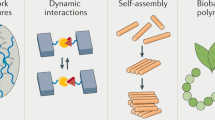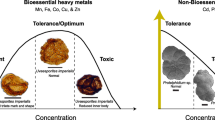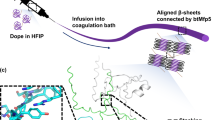Abstract
The selective capture of heavy metal ions is a persistent challenge in environmental remediation owing to the chemical similarities among metal ions and the need for high affinity, selectivity, and capacity. Biological systems have evolved efficient mechanisms to regulate metal ions, utilizing proteins such as phytochelatin, metallothionein, and lanmodulin. These biomacromolecules achieve affinity, selectivity, and capacity for metal ions at biologically relevant levels through well-organized structural motifs, inspiring the design of synthetic polymers with biomimetic functions. This focus review provides an overview of research on heavy metal-binding proteins and explores how these proteins inspired researchers to develop bioinspired and biointegrated materials. First, key structural and thermodynamic features of heavy metal-binding proteins and their roles in metal detoxification and homeostasis are discussed. Then, recent advancements in emerging materials that mimic these biological functions using synthetic peptides, polymers, and peptoids are highlighted. Finally, we review integrated systems that directly incorporate biological components with synthetic polymers to create advanced heavy metal adsorbents. Together, these approaches illustrate how bioinspired and biosynthetic integration strategies are driving innovations in heavy metal ion capture technologies. Continued interdisciplinary research promises to deliver next-generation materials with improved efficiency, specificity, and environmental compatibility for real-world applications.
This is a preview of subscription content, access via your institution
Access options
Subscribe to this journal
Receive 12 print issues and online access
$259.00 per year
only $21.58 per issue
Buy this article
- Purchase on SpringerLink
- Instant access to full article PDF
Prices may be subject to local taxes which are calculated during checkout




Similar content being viewed by others
References
Jaishankar M, Tseten T, Anbalagan N, Mathew BB, Beeregowda KN. Toxicity, mechanism and health effects of some heavy metals. Interdiscip Toxicol. 2014;7:60.
Yan A, Wang Y, Tan SN, Mohd Yusof ML, Ghosh S, Chen Z. Phytoremediation: a promising approach for revegetation of heavy metal-polluted land. Front Plant Sci. 2020;11:359.
Dixit, Wasiullah R, Malaviya D, Pandiyan K, Singh UB, Sahu A, et al. Bioremediation of Heavy metals from soil and aquatic environment: an overview of principles and criteria of fundamental processes. Sustainability. 2015;7:2189–212.
Sholl DS, Lively RP. Seven chemical separations to change the world. Nature. 2016;532:435–37.
Bolisetty S, Peydayesh M, Mezzenga R. Sustainable technologies for water purification from heavy metals: review and analysis. Chem Soc Rev. 2019;48:463–87.
Werber JR, Osuji CO, Elimelech M. Materials for next-generation desalination and water purification membranes. Nat Rev Mater. 2016;1:16018.
Sazali N, Harun Z, Sazali N. A review on batch and column adsorption of various adsorbent towards the removal of heavy metal. J Adv Res Fluid Mech Therm Sci. 2020;67:66–88.
Malik DS, Jain CK, Yadav AK. Heavy metal removal by fixed-bed column–a review. ChemBioEng Rev. 2018;5:173–79.
Remelli M, Nurchi VM, Lachowicz JI, Medici S, Zoroddu MA, Peana M. Competition between Cd (II) and other divalent transition metal ions during complex formation with amino acids, peptides, and chelating agents. Coord Chem Rev. 2016;327:55–69.
Qasem NA, Mohammed RH, Lawal DU. Removal of heavy metal ions from wastewater: A comprehensive and critical review. npj Clean Water. 2021;4:1–15.
Cobbett CS. Phytochelatin biosynthesis and function in heavy-metal detoxification. Curr Opin Plant Biol. 2000;3:211–16.
Cobbett C, Goldsbrough P. Phytochelatins and metallothioneins: roles in heavy metal detoxification and homeostasis. Annu Rev Plant Biol. 2002;53:159–82.
Carrasco-Gil S, Álvarez-Fernández A, Sobrino-Plata J, Millán R, Carpena-Ruiz R, Leduc D, et al. Complexation of Hg with phytochelatins is important for plant Hg tolerance. Plant Cell Environ. 2011;34:778–91.
Dorčák V, Krężel A. Correlation of acid–base chemistry of phytochelatin PC2 with its coordination properties towards the toxic metal ion Cd(II). Dalton Trans. 2003;11:2253–59.
Chekmeneva E, Prohens R, Díaz-Cruz JM, Ariño C, Esteban M. Thermodynamics of Cd2+ and Zn2+ binding by the phytochelatin (γ-Glu-Cys)4-Gly and its precursor glutathione. Anal Biochem. 2008;375:82–89.
Chekmeneva E, Gusmão R, Díaz-Cruz JM, Ariño C, Esteban M. From cysteine to longer chain thiols: thermodynamic analysis of cadmium binding by phytochelatins and their fragments. Metallomics. 2011;3:838–46.
Wątły J, Łuczkowski M, Padjasek M, Krężel A. Phytochelatins as a Dynamic System for Cd(II) Buffering from the Micro- to Femtomolar Range. Inorg Chem. 2021;60:4657–75.
Margoshes M, Vallee BL. A cadmium protein from equine kidney cortex. J Am Chem Soc. 1957;79:4813–14.
Klaassen CD, Liu J, Choudhuri S. Metallothionein: an intracellular protein to protect against cadmium toxicity. Annu Rev Pharm Toxicol. 1999;39:267–94.
Kaegi JHR, Schaeffer A. Biochemistry of metallothionein. Biochemistry. 1988;27:8509–15.
Furey W, Robbins A, Clancy L, Winge D, Wang B, Stout C. Crystal structure of Cd, Zn metallothionein. Science. 1986;231:704–10.
Dallinger R, Berger B, Hunziger P, Kgi JHR. Metallothionein in snail Cd and Cu metabolism. Nature. 1997;388:237–38.
Erk M, Raspor B. Evaluation of cadmium–metallothionein stability constants based on voltammetric measurements. Anal Chim Acta. 1998;360:189–94.
Krȩżel A, Maret W. Dual Nanomolar and Picomolar Zn(II) binding properties of metallothionein. J Am Chem Soc. 2007;129:10911–21.
Mattocks JA, Cotruvo JA. Biological, biomolecular, and bio-inspired strategies for detection, extraction, and separations of lanthanides and actinides. Chem Soc Rev. 2020;49:8315–34.
Cotruvo JA Jr., Featherston ER, Mattocks JA, Ho JV, Laremore TN. Lanmodulin: a highly selective lanthanide-binding protein from a lanthanide-utilizing bacterium. J Am Chem Soc. 2018;140:15056–61.
Zuo W, Tian M, Qi J, Zhang G, Hu J, Wang S, et al. The functions of EF-hand proteins from host and zoonotic pathogens. Microb Infect. 2025;27:105276.
Cook EC, Featherston ER, Showalter SA, Cotruvo JA Jr. Structural basis for rare earth element recognition by methylobacterium extorquens lanmodulin. Biochemistry. 2019;58:120–25.
Singer H, Drobot B, Zeymer C, Steudtner R, Daumann LJ. Americium preferred: lanmodulin, a natural lanthanide-binding protein favors an actinide over lanthanides. Chem Sci. 2021;12:15581–87.
Deblonde GJ-P, Mattocks JA, Dong Z, Wooddy PT, Cotruvo JA, Zavarin M. Capturing an elusive but critical element: Natural protein enables actinium chemistry. Sci Adv. 2021;7:eabk0273.
Gutenthaler SM, Tsushima S, Steudtner R, Gailer M, Hoffmann-Röder A, Drobot B, et al. Lanmodulin peptides – unravelling the binding of the EF-Hand loop sequences stripped from the structural corset. Inorg Chem Front. 2022;9:4009–21.
Mattocks JA, Jung JJ, Lin C-Y, Dong Z, Yennawar NH, Featherston ER, et al. Enhanced rare-earth separation with a metal-sensitive lanmodulin dimer. Nature. 2023;618:87–93.
Autry HA, Holcombe JA. Cadmium, copper and zinc complexes of poly-L-cysteine. Analyst. 1995;120:2643–48.
Satofuka H, Fukui T, Takagi M, Atomi H, Imanaka T. Metal-binding properties of phytochelatin-related peptides. J Inorg Biochem. 2001;86:595–602.
Cheng Y, Yan Y-B, Liu J. Spectroscopic characterization of metal bound phytochelatin analogue (Glu–Cys)4–Gly. J Inorg Biochem. 2005;99:1952–62.
Shukla D, Tiwari M, Tripathi RD, Nath P, Trivedi PK. Synthetic phytochelatins complement a phytochelatin-deficient Arabidopsis mutant and enhance the accumulation of heavy metal(loid)s. Biochem Biophys Res Commun. 2013;434:664–69.
Viswanathan K, Schofield MH, Teraoka I, Gross RA. Surprising metal binding properties of phytochelatin-like peptides prepared by protease-catalysis. Green Chem. 2012;14:1020–29.
Bontidean I, Ahlqvist J, Mulchandani A, Chen W, Bae W, Mehra RK, et al. Novel synthetic phytochelatin-based capacitive biosensor for heavy metal ion detection. Biosens Bioelectron. 2003;18:547–53.
Knight AS, Zhou EY, Francis MB. Development of peptoid-based ligands for the removal of cadmium from biological media. Chem Sci. 2015;6:4042–48.
Voltrova S, Hidasova D, Genzer J, Srogl J. Metallothionein-inspired prototype of molecular pincer. Chem Commun. 2011;47:8067–69.
Sharma G, Kandasubramanian B. Molecularly imprinted polymers for selective recognition and extraction of heavy metal ions and toxic dyes. J Chem Eng Data. 2020;65:396–418.
Nakahata M, Sumiya A, Ikemoto Y, Nakamura T, Dudin A, Schwieger J, et al. Hyperconfined bio-inspired polymers in integrative flow-through systems for highly selective removal of heavy metal ions. Nat Commun. 2024;15:5824.
Nakahata M, Okamoto C, Tanaka M, Hashidzume A. Cadmium Ion Adsorption Properties of Polyanions Carrying Carboxylate and Thiol-Containing Amino Acid Residues. ACS Appl Polym Mater. 2025. https://doi.org/10.1021/acsapm.5c00381. in press.DOI.
Ejima R, Nakahata M, Kamon Y, Hashidzume A. Synthesis and metal ion adsorption properties of a dense triazole polymer carrying cysteine residues. J Polym Sci. 2025;63:1570–79.
Xu Z, Bae W, Mulchandani A, Mehra RK, Chen W. Heavy Metal Removal by Novel CBD-EC20 Sorbents Immobilized on Cellulose. Biomacromolecules. 2002;3:462–65.
Esser-Kahn AP, Iavarone AT, Francis MB. Metallothionein-cross-linked hydrogels for the selective removal of heavy metals from water. J Am Chem Soc. 2008;130:15820–22.
Garifullin R, Ustahuseyin O, Celebioglu A, Cinar G, Uyar T, Guler MO. Noncovalent functionalization of a nanofibrous network with a bio-inspired heavy metal binding peptide. RSC Adv. 2013;3:24215–21.
Mansour MS, Ossman ME, Farag HA. Removal of Cd(II) ion from waste water by adsorption onto polyaniline coated on sawdust. Desalination. 2011;272:301–05.
Saini S, Katnoria JK, Kaur I. A comparative study for removal of cadmium(II) ions using unmodified and NTA-modified Dendrocalamus strictus charcoal powder. J Environ Health Sci Eng. 2019;17:259–72.
Radha E, Gomathi T, Sudha PN, Sashikala S. Cadmium(II) ion removal from aqueous solution using chitosan oligosaccharide-based blend. Polym Bull. 2021;78:1109–32.
Puspitasari T, Oktaviani, Pangerteni DS, Nurfilah E, Darwis D. Study of metal ions removal from aqueous solution by using radiation crosslinked chitosan-co-Poly(Acrylamide)-based adsorbent. Macromol Symp. 2015;353:168–77.
Liu Y, Hu L, Tan B, Li J, Gao X, He Y, et al. Adsorption behavior of heavy metal ions from aqueous solution onto composite dextran-chitosan macromolecule resin adsorbent. Int J Biol Macromol. 2019;141:738–46.
Abdel-Halim ES, Al-Deyab SS. Preparation of poly(acrylic acid)/starch hydrogel and its application for cadmium ion removal from aqueous solutions. React Funct Polym. 2014;75:1–8.
Wang W-B, Huang D-J, Kang Y-R, Wang A-Q. One-step in situ fabrication of a granular semi-IPN hydrogel based on chitosan and gelatin for fast and efficient adsorption of Cu2+ ion. Colloids Surf B Biointerfaces. 2013;106:51–59.
Acknowledgements
M.N. acknowledges the Japan Society for the Promotion of Science (JSPS) KAKENHI Grant Number JP19H05719. M.N. expresses gratitude to Prof. A. Hashidzume (The University of Osaka) for fruitful discussions and comments.
Author information
Authors and Affiliations
Corresponding author
Ethics declarations
Conflict of interest
The authors declare no competing interests.
Additional information
Publisher’s note Springer Nature remains neutral with regard to jurisdictional claims in published maps and institutional affiliations.
Rights and permissions
Springer Nature or its licensor (e.g. a society or other partner) holds exclusive rights to this article under a publishing agreement with the author(s) or other rightsholder(s); author self-archiving of the accepted manuscript version of this article is solely governed by the terms of such publishing agreement and applicable law.
About this article
Cite this article
Nakahata, M. Bioinspired and biosynthetic integrated polymeric materials for the selective capture of heavy metal ions. Polym J (2025). https://doi.org/10.1038/s41428-025-01092-y
Received:
Revised:
Accepted:
Published:
DOI: https://doi.org/10.1038/s41428-025-01092-y



